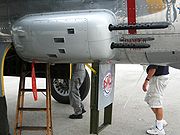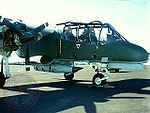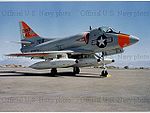
U.S. aircraft gun pods
Encyclopedia

Gun pod
A gun pod is a detachable pod or pack containing machine guns or automatic cannon and ancillaries, mounted externally on a vehicle such as a military aircraft which may or may not also have its own guns....
as a concept largely came into its prime during and period following World War II
World War II
World War II, or the Second World War , was a global conflict lasting from 1939 to 1945, involving most of the world's nations—including all of the great powers—eventually forming two opposing military alliances: the Allies and the Axis...
. So-called "package gun" installations on US medium and light bombers, such as the B-25 Mitchell
B-25 Mitchell
The North American B-25 Mitchell was an American twin-engined medium bomber manufactured by North American Aviation. It was used by many Allied air forces, in every theater of World War II, as well as many other air forces after the war ended, and saw service across four decades.The B-25 was named...
and A-26 Invader
A-26 Invader
The Douglas A-26 Invader was a United States twin-engined light attack bomber built by the Douglas Aircraft Co. during World War II that also saw service during several of the Cold War's major conflicts...
, were probably the first such attempts by the United States military. One of the primary ideas was to provide additional suppression of ground defenses during attack runs, primarily while conducting maritime interdiction, and the extra armament gave the aircraft additional firepower.
With the rise of the missile in the post-WWII period many United States aircraft were produced without internal guns, but it was quickly found that guns were still needed both for air-to-air combat and close air support
Close air support
In military tactics, close air support is defined as air action by fixed or rotary winged aircraft against hostile targets that are close to friendly forces, and which requires detailed integration of each air mission with fire and movement of these forces.The determining factor for CAS is...
. Gun pods offered a simple means of giving aircraft this capability, with no weight penalty on missions where guns were not required.
The United States has developed a number of systems for use both on fixed wing aircraft and helicopters, and an overview is provided here.
Descriptions of models
- XM12/M12 and SUU-16/A
Developed as a pod for high-speed fighter aircraft which lacked a gun, this pod was fitted with a single M61A1
M61 Vulcan
The M61 Vulcan is a hydraulically or pneumatically driven, six-barreled, air-cooled, electrically fired Gatling-style rotary cannon which fires 20 mm rounds at an extremely high rate. The M61 and its derivatives have been the principal cannon armament of United States military fixed-wing aircraft...
20 mm cannon and 1,200 rounds of ammunition. This weapon is powered by a ram-air turbine
Ram air turbine
A ram air turbine is a small turbine that is connected to a hydraulic pump, or electrical generator, installed in an aircraft and used as a power source...
, and fires at a fixed rate of 6,000 rpm. However, for this firing rate to be achieved the aircraft needs to fly over 300 mi/h, and the pod is designed to be optimal at speeds above 400 mi/h. Its weight, 1650 lb (748.4 kg) loaded, also precludes it from many light aircraft.
The pod was designated XM12 (possibly standardized as M12) by the US Army and the same pod was designated SUU-16/A by the US Air Force. It was sometimes mounted on F-4 Phantom aircraft as a stopgap until internal-gun models entered service.
- XM13
A pod developed, likely for helicopters, fitted with a single M75
M75 grenade launcher
The M75 is a 40mm automatic grenade launcher that was used primarily as an aircraft weapon in United States service and was one of the first weapons to use the high velocity 40x53mm grenade.-Overview:...
40 mm grenade launcher. Some sources also mention this as a system tested on the JOV-1A Mohawk
OV-1 Mohawk
The Grumman OV-1 Mohawk is an armed military observation and attack aircraft, designed for battlefield surveillance and light strike capabilities. It is of twin turboprop configuration, and carried two crewmembers with side by side seating...
.
- XM14 and SUU-12/A

The pod was designated XM14 by the US army and the same pod was designated SUU-12/A by the US Air Force.
- M18 and SUU-11/A Series

The first was the XM18 and SUU-11/A, which featured a standard version of the weapon encased in an aerodynamic pod. This weapon was unmodified and fired at a rate of 6,000 rpm. The fact that the weapon only fed from a drum containing 1,500 rounds of ammunition meant that a slower rate of fire was desired.
The second set of subvariants, designated XM18E1 (and standardized as the M18) and SUU-11A/A, featured an aircraft-to-pod electric connection, allowing aircraft internal power to be used in providing better starting torque, a de-energized solenoid allowing for better round clearing at low rates of fire, and circuitry that allowed for selectable rates of fire. The options were either 2,000 rpm or 4,000 rpm, both significantly lower than the base rate of fire.
The last set of subvariants were designated M18A1 (development of the M18E1) and SUU-11B/A. These featured a slightly higher set of selectable rates of fire, either 3,000 rpm or the high 6,000 rpm.
These pods were used on a wide array of US aircraft, primarily during the Vietnam War
Vietnam War
The Vietnam War was a Cold War-era military conflict that occurred in Vietnam, Laos, and Cambodia from 1 November 1955 to the fall of Saigon on 30 April 1975. This war followed the First Indochina War and was fought between North Vietnam, supported by its communist allies, and the government of...
, including the A-1 Skyraider
A-1 Skyraider
The Douglas A-1 Skyraider was an American single-seat attack aircraft that saw service between the late 1940s and early 1980s. It became a piston-powered, propeller-driven anachronism in the jet age, and was nicknamed "Spad", after a French World War I fighter...
, A-37 Dragonfly, and the T-28 Trojan
T-28 Trojan
The North American Aviation T-28 Trojan is a piston-engined military trainer aircraft used by the United States Air Force and United States Navy beginning in the 1950s...
. It was also tested on the ACH-47A "Guns A-Go-Go" by the US Army and on the UH-1E Iroquois
UH-1 Iroquois
The Bell UH-1 Iroquois is a military helicopter powered by a single, turboshaft engine, with a two-bladed main rotor and tail rotor. The helicopter was developed by Bell Helicopter to meet the United States Army's requirement for a medical evacuation and utility helicopter in 1952, and first flew...
by the US Marine Corps, and were part of standard armament fits for the AH-1 Cobra
AH-1 Cobra
The Bell AH-1 Cobra is a two-bladed, single engine attack helicopter manufactured by Bell Helicopter. It shares a common engine, transmission and rotor system with the older UH-1 Iroquois...
with both services.
- XM19
A pod developed by the US Army, likely primarily for helicopters, fitted with two M60C
M60 machine gun
The M60 is a family of American general-purpose machine guns firing 7.62×51mm NATO cartridges from a disintegrating belt of M13 links...
7.62x51mm machine guns. Does not appear to have been standardized, likely in favor of the M18 series.
Of note, however, was the fact that this system was also tested with the S-2E Tracker
S-2 Tracker
The Grumman S-2 Tracker was the first purpose-built, single airframe anti-submarine warfare aircraft to enter service with the US Navy. The Tracker was of conventional design with twin engines, a high wing and tricycle undercarriage. The type was exported to a number of navies around the world...
by the US Naval Air Test Center, US Naval Air Station, Patuxent River
Naval Air Station Patuxent River
"Pax River" redirects here. For the river, see Patuxent River.Naval Air Station Patuxent River , also known as NAS Pax River, is a United States Naval Air Station located in St. Mary's County, Maryland on the Chesapeake Bay near the mouth of the Patuxent River. It is home to the U.S...
, Maryland
Maryland
Maryland is a U.S. state located in the Mid Atlantic region of the United States, bordering Virginia, West Virginia, and the District of Columbia to its south and west; Pennsylvania to its north; and Delaware to its east...
. There is no information as to the outcome of these tests, carried out in 1966, which apparently also involved the SUU-11A/A pod mentioned earlier.
- XM25 and SUU-23/A
Similar to the XM12/SUU-16/A, this pod featured a self-powered variant of the M61A1, designated XM130 (may have been standardized as the M130) by the US Army and GAU-4/A by the US Air Force. This modification allowed its carriage on aircraft that could not meet the speed requirement of the previous unit, and reduced drag by removing the ram-air turbine requirement. This pod was popular for use on the F-4C and F-4D Phantom II
F-4 Phantom II
The McDonnell Douglas F-4 Phantom II is a tandem two-seat, twin-engined, all-weather, long-range supersonic jet interceptor fighter/fighter-bomber originally developed for the United States Navy by McDonnell Aircraft. It first entered service in 1960 with the U.S. Navy. Proving highly adaptable,...
aircraft, as well as, British FG.1 and FGR.2 Phantom IIs. The pod still has a weight restriction, weighing more than its predecessor at 1730 lb (784.7 kg) loaded with 1,200 rounds of ammunition, and still has the fixed rate of 6,000 rpm.

- GPU-2/A
A lightweight gun pod fitted with the M197
M197 Gatling gun
The M197 electric cannon is a three-barreled electric Gatling gun developed primarily for use by United States Army helicopter gunships.Development of the M197 began in 1967 after experience in the Vietnam War revealed the inadequacy of the 7.62 mm Minigun for gunship use...
20 mm cannon, the unit weights only 586 lb (265.8 kg) loaded with 300 rounds of ammunition. It has selectable fire rates of either 700 rpm or 1,500 rpm. The pod is self-contained and powered by a Ni-Cad
Nickel-cadmium battery
The nickel–cadmium battery ' is a type of rechargeable battery using nickel oxide hydroxide and metallic cadmium as electrodes....
rechargeable battery, with sufficient charge to expend three complete loads before needing to be replaced. This weapon has been tested on the A-37 Dragonfly
A-37 Dragonfly
The Cessna A-37 Dragonfly, or Super Tweet, is a United States light attack aircraft developed from the T-37 Tweet basic trainer in the 1960s and 1970s...
and OV-10 Bronco
OV-10 Bronco
The North American Aviation Rockwell OV-10 Bronco is a turboprop light attack and observation aircraft. It was developed in the 1960s as a special aircraft for counter-insurgency combat, and one of its primary missions was as a forward air control aircraft...
.
- GPU-5/A
Developed under Project Pave Claw, the GPU-5/A was designed to adapt the power of the A-10 Thunderbolt II
A-10 Thunderbolt II
The Fairchild Republic A-10 Thunderbolt II is an American single-seat, twin-engine, straight-wing jet aircraft developed by Fairchild-Republic in the early 1970s. The A-10 was designed for a United States Air Force requirement to provide close air support for ground forces by attacking tanks,...
and its GAU-8/A
GAU-8 Avenger
The General Electric GAU-8/A Avenger is a 30 mm, hydraulically-driven seven-barrel Gatling-type rotary cannon that is mounted on the United States Air Force's Fairchild Republic A-10 Thunderbolt II. It is among the largest, heaviest and most powerful aircraft cannons in the United States military...
gun to smaller aircraft. The resulting weapon used a smaller version of the GAU-8/A, designated the GAU-13/A
GAU-13 cannon
The General Electric GAU-13/A is a 30 mm electric Gatling Gun derived from the GAU-8 Avenger cannon.-Description:The GAU-13 was developed in the late 1970s for use in gun pod applications for fighter aircraft and attack aircraft use, primarily for air-to-ground and anti-tank attacks.The GAU-13/A is...
, with only four barrels. Podded, the system weights 1900 lb (861.8 kg) loaded with 353 rounds of 30 mm ammunition in two helical layers surrounding the gun (for reduction of overall size). The pod is completely self-contained with a rate of fire of 3,000 rpm.

- Mk 4 Mod 0
Developed by the US Navy, this pod is fitted with the Mk 11 Mod 5 20 mm cannon, along with 750 rounds of ammunition. This pod is said to have been used on a variety of US Navy and Marine Corps aircraft including the A-4 Skyhawk
A-4 Skyhawk
The Douglas A-4 Skyhawk is a carrier-capable ground-attack aircraft designed for the United States Navy and United States Marine Corps. The delta winged, single-engined Skyhawk was designed and produced by Douglas Aircraft Company, and later McDonnell Douglas. It was originally designated the A4D...
, F-4 Phantom II
F-4 Phantom II
The McDonnell Douglas F-4 Phantom II is a tandem two-seat, twin-engined, all-weather, long-range supersonic jet interceptor fighter/fighter-bomber originally developed for the United States Navy by McDonnell Aircraft. It first entered service in 1960 with the U.S. Navy. Proving highly adaptable,...
, A-7 Corsair II
A-7 Corsair II
The Ling-Temco-Vought A-7 Corsair II is a carrier-based subsonic light attack aircraft introduced to replace the United States Navy's Douglas A-4 Skyhawk, initially entering service during the Vietnam War...
,and OV-10 Bronco
OV-10 Bronco
The North American Aviation Rockwell OV-10 Bronco is a turboprop light attack and observation aircraft. It was developed in the 1960s as a special aircraft for counter-insurgency combat, and one of its primary missions was as a forward air control aircraft...
. Approximately 1200 Mk 4 Gun Pods were manufactured by Hughes Tool Company, later Hughes Helicopter, in Culver City, California. While the system was tested and certified for use on the A-4, the A-6, the A-7, the F-4, and the OV-10, it only saw extended use on the A-4, the F-4, and the OV-10. In the case of the OV-10, the unit was used by VAL-4, a Navy squadron assigned to Binh Thuy, Vietnam, and was used extensively for close air support missions.

